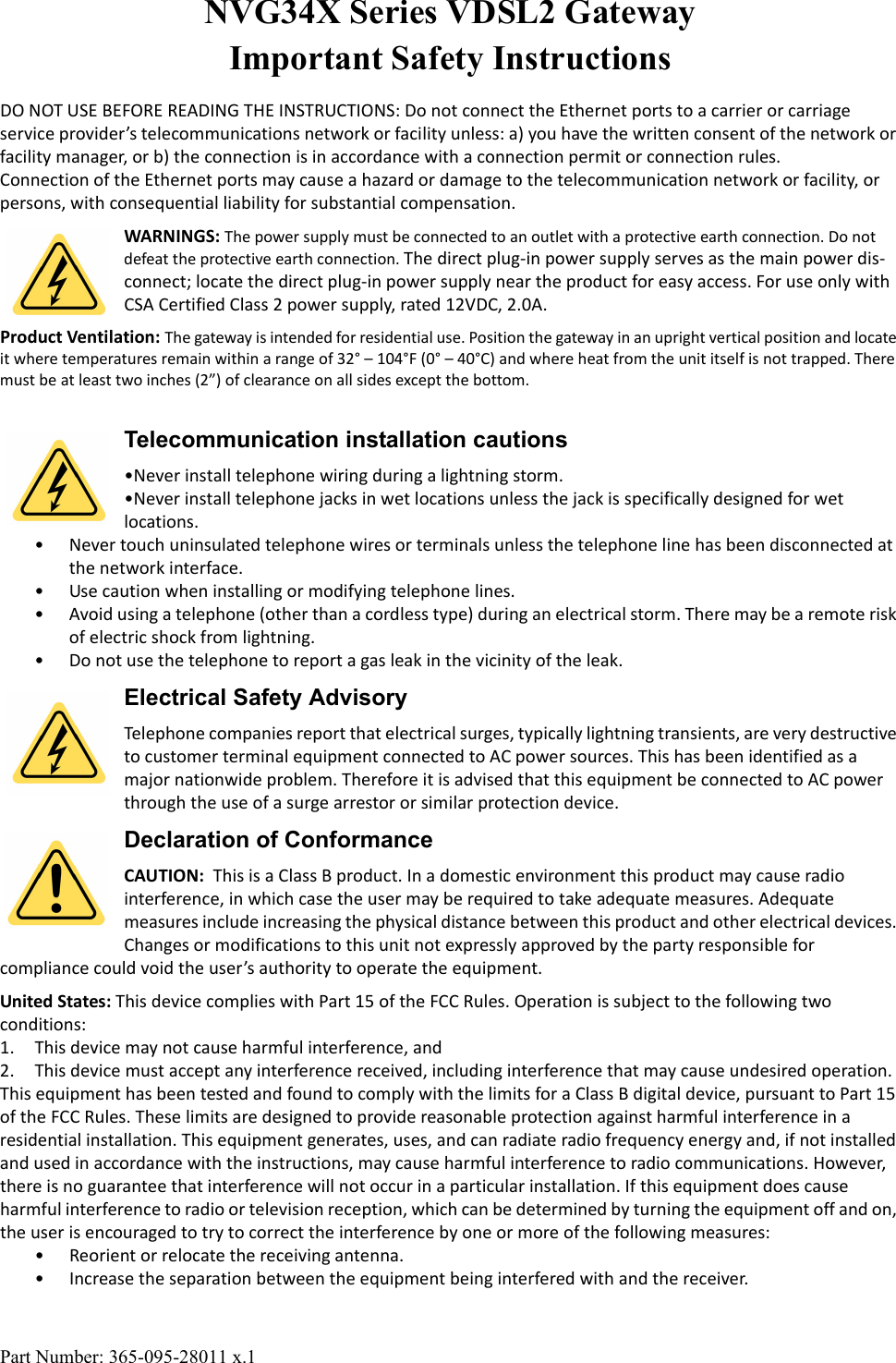ARRIS NVG34NX4 NVG34X Series VDSL2 Gateway User Manual Safety Statement
ARRIS Group, Inc. NVG34X Series VDSL2 Gateway Safety Statement
ARRIS >
Contents
- 1. User Manual (Statement)_rev 2.pdf
- 2. User Manual_rev.pdf
User Manual (Statement)_rev 2.pdf

![Part Number: 365-095-28011 x.1• Connect the device to an outlet on a circuit different from the outlet to which the equipment being interfered with is connected.• Consult the retailer or an experienced radio/TV technician for help.United States: This device complies with 47 CFR Part 68 of the FCC Rules. Operation is subject to the following four conditions:1. The Federal Communications Commission (FCC) has established Rules which permit this device to be directly connected to the telephone network. Standardized jacks are used for these connections. This equipment should not be used on party lines or coin phones.2. If this device is malfunctioning, it may also be causing harm to the telephone network; this device should be disconnected until the source of the problem can be determined and until repair has been made. If this is not done, the telephone company may temporarily disconnect service.3. The telephone company may make changes in its technical operations and procedures; if such changes affect the compatibility or use of this device, the telephone company is required to give adequate notice of the changes. You will be advised of your right to file a complaint with the FCC.4. If the telephone company requests information on what equipment is connected to their lines, inform them of:• The telephone number to which this unit is connected.• The ringer equivalence number. [0.XB] (Indicated on the label)• The USOC jack required. [RJ11C]• The FCC Registration Number. [XXXUSA-XXXXX-XX-E] (Indicated on the label)The Ringer Equivalence Number (REN) is used to determine how many devices can be connected to your telephone line. In most areas, the sum of the REN's of all devices on any one line should not exceed five (3.0). If too many devices are attached, they may not ring properly.FCC Caution: Any changes or modifications not expressly approved by the party responsible for compliance could void the user’s authority to operate this equipment. This transmitter must not be co-located or operating in conjunction with any other antenna or transmitter. For operation within 5.15 ~ 5.25 GHz/ 5.47 ~ 5.725GHz frequencyrange, it is restricted to indoor environment. The band from 5600—5650Mhz will be disabled by the software during the manufacturing and cannot be changed by the end user. This device meets all the other requirements specified inPart 15E, Section 15.407 of the FCC Rules. Radiation Exposure Statement: This equipment complies with FCC radiation exposure limits as set forth for an uncontrolled environment. This equipment should be installed and operated maintaining a minimum distance of 24 cm between the device and your body.Service Requirements: In the event of equipment malfunction, if under warranty, we will exchange a product deemed defective. Under FCC rules, no customer is authorized to repair this equipment. This restriction applies regardless of whether the equipment is in or out of warranty. Technical Support for Hardware Products:Customers inside North America: 888-944-4357 (888-944-HELP)Customers outside North America: 1-215-323-2345For Spanish language support: 1-215-323-2346IMPORTANT: This product was tested for FCC compliance under conditions that included the use of shielded cables and connectors between system components. Changes or modifications to this product not authorized by the manufacturer could void your authority to operate the equipment.Canada: This Class B digital apparatus meets all requirements of the Canadian Interference-Causing Equipment Regulations.Cet appareil numérique de la classe B respecte toutes les exigences du Réglement sur le matériel brouilleur du Canada.RF Exposure Statement:Installation of the wireless models must maintain at least 24 cm between the wireless NVG34x device and any body part of the user to be in compliance with FCC RF exposure guidelines.Country Code Selection Usage:The country code selection is for non-US models only and is not available to US models. US marketed models are fixed to US operation channels only.](https://usermanual.wiki/ARRIS/NVG34NX4.User-Manual-Statement-rev-2-pdf/User-Guide-2560291-Page-2.png)